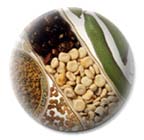- Home
- Introductions

|
Vegetable Seed Production: Dry Seed PrinciplesVegetable seed crops are divided into two categories based on the type of fruit harvested. Dry-seeded fruits include the brassicas, legumes, and onion and wet-seeded fruits include the cucurbits, melons, and tomatoes. The methods of harvest and extraction of seeds vary dependent on the type of fruit harvested. Of great concern in dry-seeded fruit vegetable seed production is the potential for loss of yield due to seed shattering when harvesting occurs after physiological maturity. To minimize seed loss, two approaches are employed. Since many dry-seeded vegetables achieve physiological maturity before harvest maturity, they are cut while the plant is still green and placed into rows where the wind further dries the plant and its reproductive structure. This permits more uniform maturation of all dry-seeded fruits and seed quality is enhanced compared to the more costly option of sequential harvest of mature fruits. Later, after the seeds have reached harvest maturity, they are extracted from the seed heads either by hand or mechanically using a combine. The second approach is to visually monitor the development of the dry-seeded fruit and harvest the crop before shattering occurs. For example, onion seeds are very susceptible to shattering once the florets have dried and seed germination and quality is reduced if the scape stalks are cut too early. A common harvest criterion has been to examine umbels for the first mature seeds. In indeterminate crops such as carrot, seeds mature in sequential order with those on the primary umbel maturing first followed by those on secondary and tertiary umbels. Secondary umbels produce about 50% the quantity of pure live seed of the primary umbel. Thus, harvest of this dry-seeded crop is complicated by the umbel maturation sequence. Seeds produced from the first lettuce flowers also tend to be larger and of higher quality than seeds produced from later flowers. Conventional harvest methods for dry-seeded vegetable seed crops based on their mature reproductive structures (courtesy of J. J. Steiner).
|
||||||||